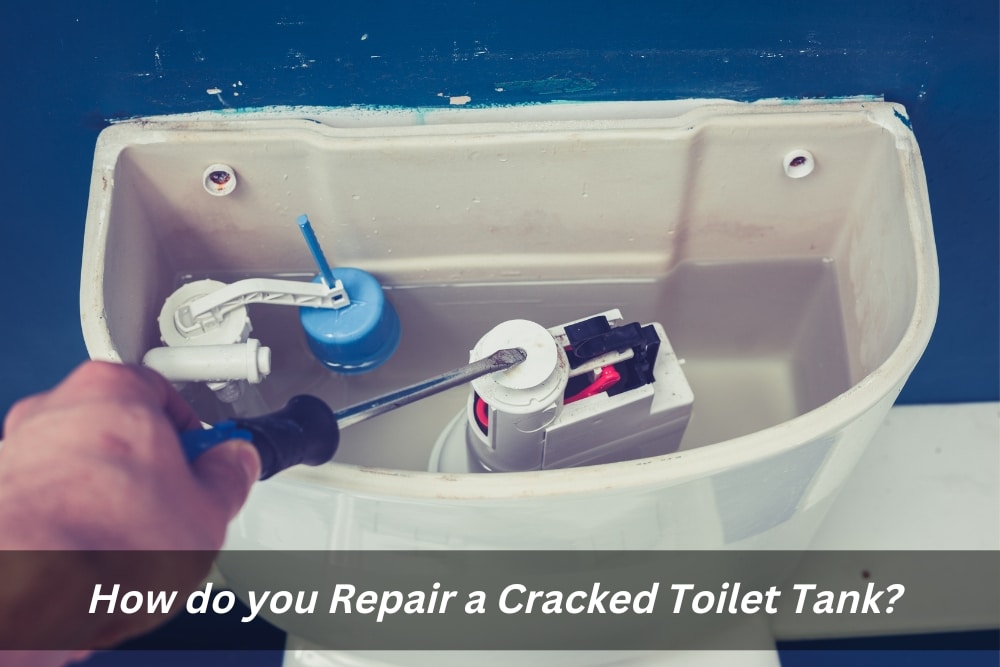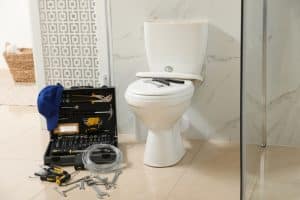Types of Cracks in Toilet Tanks
If you are having problems with your cracked toilet tank, the first thing you should do is check the water level. If it’s too low, it may be because of a crack in the toilet bowl and if that is not the case, then you should flush the toilet to drain and check for cracks. Next, you can use a plunger to try and unclog any hairline cracks or use a putty knife if there are large cracks in your toilet.
If these steps don’t work, then there may be a problem with your tank or you should replace the toilet tank. You can remove the tank from underneath your toilet to inspect it for leaks or cracks.
Another common type of crack is one that is below the waterline. This type of crack can be caused by impact, such as when something heavy falls on the tank, or from constant stress, such as from the tank being mounted on an uneven surface. Be with me, let’s fix a toilet tank.
Finally, there are also cracks that can form on the inside or outside of the tank. These cracks can be caused by a variety of factors, including corrosion, wear and tear, and manufacturing defects.
There are three types of cracks that can form on toilet tanks around the base, at the seam where the tank and bowl meet, or on the side of the tank. If you notice a leak and suspect it’s coming from the toilet tank, start by checking the seals between the tank and bowl. Next, check carefully for any cracks in the porcelain. If you find a significant crack, you’ll have to replace the entire tank.
Once you’ve turned off the valve and drained the tank, you can use a repair kit to fix a hairline crack. Be sure to mix the epoxy as instructed and apply it carefully both from inside the tank and onto the exterior surface. When the epoxy has dried, get fine-grit sandpaper and sand down any excess epoxy on the exterior surface. After that, rejoin the water supply line to the toilet tank.
Hairline cracks
Small hairline cracks in toilet tanks can often be repaired by using a plumber’s putty or a waterproof silicone epoxy sealant. The repair is best performed when the tank is drained, dried out, and filled with putty or epoxy. If larger cracks are leaking considerably, the safest option may be to replace the entire tank.
However, if your toilet tank has a significant crack, you will have to replace it. Turning off the valve and flushing the toilet will drain the tank. Once it is dry, use a repair kit and mix epoxy according to instructions.
You should be able to purchase this at your local hardware store. Carefully apply epoxy onto hairline cracks on both the inside and outside of the tank. When the epoxy has dried, get fine-grit sandpaper and sand away any excess epoxy on the exterior surface. Afterwards, reconnect the water supply line to the toilet tank.
Cracks in toilet tanks can be caused by a variety of factors, the most common being aging. As tankage, it becomes more brittle and is more likely to break. Improper installation can also cause cracks, as well as misuse such as slamming the toilet seat or dropping heavy objects on the tank. If you have a toilet tank with any visible cracks, it should be replaced immediately to avoid serious problems down the road.
Step cracks
If you see a step crack in your toilet tank, it is important to fix it as soon as possible. This type of crack can damage the tank and cause water leakage. You can use sealant or plumber’s putty to fix the crack, but make sure to follow the manufacturer’s instructions for how long to wait before flushing.
Bowl cracks
There are three types of cracks in toilet tanks: hairline, impact, and age. Hairline cracks form when the tank is hit by something or when someone puts pressure on it. The impact of a crack in the toilet bowl usually happens when the tank is hit by something heavy. Age cracks develop over time due to manufacturing imperfections or accidents.
Water leaks
Water leakage around toilets is a common issue that can be caused by a number of different things, such as cracks in the tank or bowl, a broken flapper, or simply old age. Flex Shot is an easy-to-use sealant that helps to prevent water from leaking and creates a waterproof barrier. This makes the area around the toilet look better and can help to avoid costly repairs in the future.
How to Repair a Small Crack in a Toilet Tank
Repairing a small crack in a toilet tank is a fairly easy process. First, switch off the water endow to the toilet using the valve behind it. Next, remove any standing water level inside the tank with a sponge. Then, get a repair kit and mix epoxy as instructed. Apply epoxy onto both the inside of the tank and the outside surface, then leave to dry for 12 hours.
If you have a small crack in your toilet tank, do not worry! It can easily be fixed with a new seal, which is available at your local hardware store. The repair is easy and does not require any professional help. Simply send off the excess epoxy from the exterior of the tank with fine-grit sandpaper and reconnect the water supply line. Finally, flush the toilet to ensure it works properly.
In the event that your toilet tank has a small crack, you can fix it yourself using a few simple tools and some sealant. You’ll need to purchase these items at your local hardware store. First, apply the sealant over the entire crack until it’s fully covered. Wait for it to dry before using the toilet again. If the crack is too large to be fixed with sealant, you’ll need to remove the tank and replace it with a new one. To do this, remove the bolts that hold the tank to the bowl floor.
First, remove the bolts that are holding the tank to the bowl by prying them up on one end until they come loose from their threads. Then pull them out of their holes in the bottom of the bowl. Next, place a level on top of each end of the newly removed bolt and use pliers to tighten them against the level so they are flush with both surfaces of the bowl (the top and bottom). Finally, replace any screws that were lost during removal or installation.
Turn off the water supply to the toilet
If you have a large crack in your toilet tank, one way to fix it is to turn off the water supply. If there is a small crack then have a look crack is located. You can do this by locating the shut-off valve near the toilet and turning it off. Then, flush the toilet to drain the tank and bowl. Apply the plumber’s putty or silicone sealant on the cracks and wait for the recommended amount of time. Turn on the water supply to the toilet and turn off the water supply again using the shut-off valve.
Flush the toilet and remove as much water from the tank as possible
If you have a small crack in your toilet tank, you can fix it by turning off the water supply to the toilet at the shutoff valve below the tank, flushing it to drain water, and removing standing water from the tank or bowl. Wipe the porcelain dry when you’re done.
Use a putty knife to remove any caulk around the hairline crack
If you have a small crack in your toilet tank, you can fix it using epoxy or a plumber’s putty. Applied Epoxy is a quick fix that sets in 30 minutes but must be applied quickly. The plumber’s putty remains malleable for most of its usage, so it is better if you have some time to work with it. If you don’t want to use either of those options, Flex Shot is an easy-to-use sealant that comes in a tube and doesn’t require a caulk gun. It forms a rubber-like seal and repels water.
Apply resin to both sides of the crack and let it dry
There are a few ways to repair a small crack in a toilet tank. The most common is to mix two parts of epoxy and apply it to the crack with a putty spike or long-handled. Smooth and flatten the epoxy as much as possible for the best appearance. Let the epoxy cure overnight, or as recommended by the manufacturer. Another way is to use a caulking gun and put the caulk in the crack.
Epoxy is a great way to fix a small crack in a toilet tank. Spreading epoxy on both sides of the crack lets it dry. Once it’s dry, use plumbers’ putty to fill any gaps. Let the caulk dry overnight before using a plunger to clear any excess water from the area. To prevent future leaks, make sure your toilet is properly flushed and levelled.
Reattach the tank to the bowl and re-caulk around the hairline crack
If you have a small crack in your toilet tank, you can fix it by turning off the water, drying the tank, and applying silicone plumbing epoxy. Smooth the sealer out and allow it to dry before refilling the tank with water. If you have a hairline crack in your tank or bowl, you can stop the leak by sealing it with waterproof epoxy.
How to Repair a Large Crack in a Toilet Tank
Repairing a large crack in a crack in a toilet tank is not difficult, but it is important to take your time and follow the steps carefully. First, turn off the water supply using the valve behind the toilet. Flush the toilet to drain the tank and then use a bucket to scoop out any standing water. Disconnect the supply line from the tank and wipe it down with a chamois cloth to ensure it’s completely dry. Finally, use pliers to reconnect the supply line and you’re done!
If you have a large crack in your toilet tank, you can repair it by using epoxy. Carefully apply epoxy onto the hairline crack from both the inside and outside surfaces. Leave it to dry for 12 hours, then sandpaper off any excess epoxy. Finally, reconnect the water supply line and turn on the water valve.
If you have a large crack in your toilet tank, please do not try to fix it yourself. It is important to call a plumber right away as they can repair the tank and prevent any further damage from occurring. The plumber will use caulk to seal the crack and may need to replace some of the tank’s hardware. Be sure to check for leaks after the repair is complete.
Turn off the water supply to the toilet
In order to repair a large crack in a toilet tank, you will need to turn off the water supply. The shutoff valve is usually located under the toilet tank. Once the water has been turned off, you can drain the tank and bowl by flushing the toilet.
Be sure to remove as much excess water from the tank and bowl as possible before applying the plumber’s putty or silicone sealant to the cracks. Make sure both the inside and outside of the crack are well-sealed before waiting for the recommended time period according to sealant manufacturer instructions.
Now that the water has been turned off, it is time to drain the tank. Flush the toilet and let it run until all of the water is gone. Once the tank is drained, set the lid aside on some towels or padding so as not to damage them during the removal of the vessel from either the wall or floor. Finally, turn off the water supply using the valve that is typically located at the base of the wall behind the tank or in the floor area where the toilet is installed.
Flush the toilet and sponge out as much water as possible
The average lifespan of a toilet is 25 years. A rubber-like seal that actually repels water can be used to prevent leaks in the toilet. To apply Flex Shot to the toilet, you should turn off the water supply. Flush the toilet after applying Flex Shot and before shutting off the valve on top of the tank.
After using Flex-Shot on your toilet, dip a sponge into the standing water in the bowl and wring it out into a bucket to remove residual water. You may need to do this multiple times until the water is clear.
Clean the area around the crack
The average lifespan of a toilet is 25 years. A rubber-like seal that actually repels water can be used to prevent leaks in the toilet. To apply Flex Shot to the toilet, you should turn off the water supply. Flush the toilet after applying Flex Shot and before shutting off the valve on top of the tank.
After using Flex-Shot on your toilet, dip a sponge into the standing water in the bowl and wring it out into a bucket to remove residual water. You may need to do this multiple times until the water is clear.
Apply epoxy putty to the crack and smooth it out
Epoxy putty is a two-part material that must be mixed before use. It can be applied to cracks and then smoothed out. Let it cure overnight or as recommended by the manufacturer for the best results.
Let the epoxy putty dry completely
When using epoxy putty to fix a crack in your aquarium, it is important to let the silicone epoxy dry completely. This usually takes around 24 hours. You should inspect the repair on an hourly basis. Be sure to check for other glazing cracks, either visible or near invisible, once the repair dries. If no such cracks appear, you can refill the tank and test your work.
Be sure to mix the two parts of the epoxy (catalyst and resin) as directed by the manufacturer before applying it to the crack. The mixed epoxy must be applied within its working time, usually no more than 30 minutes.
Turn on the water supply and check for leaks
Turning off the water supply to a toilet is a basic plumbing repair that can be done by anyone. Shutting off the valve and disconnecting the hose will stop the flow of water to the toilet. Checking for leaks and flushing once repaired is important to make sure everything is working properly.
First, turn on the water supply and check for leaks. If the tank is leaking, you’ll need to fix that before continuing. Next, use a caulk gun to apply a bead of silicone caulk around the outside of the toilet valve. Finally, use plumbers’ putty to seal the crack between the tank and the bowl.
Turning off the water supply to the toilet is a good way to prevent flooding while you’re repairing it. You can do this by turning the valve that’s located behind the toilet. After that, you’ll want to check for any leaks before proceeding. If there are no leaks, you can go ahead and replace the ballcock valve or stop valve. To do this, loosen the nut by turning it counterclockwise with your hand wrench or pliers.
Then lift it off slightly so you can replace it with a new one from your plumbing supply store or home centre. If there is no ballcock attached to the handle, simply unscrew both parts and replace them together as one unit (ballcock & handle).
Hold onto this part for future reference you’ll need it later when replacing stop valves on other toilets in your house! Then reattach by tightening down their nuts using your hand wrench or pliers (or using an adjustable wrench). Once you’ve shut off the water supply turned it back on and eliminated any visible leaks.



